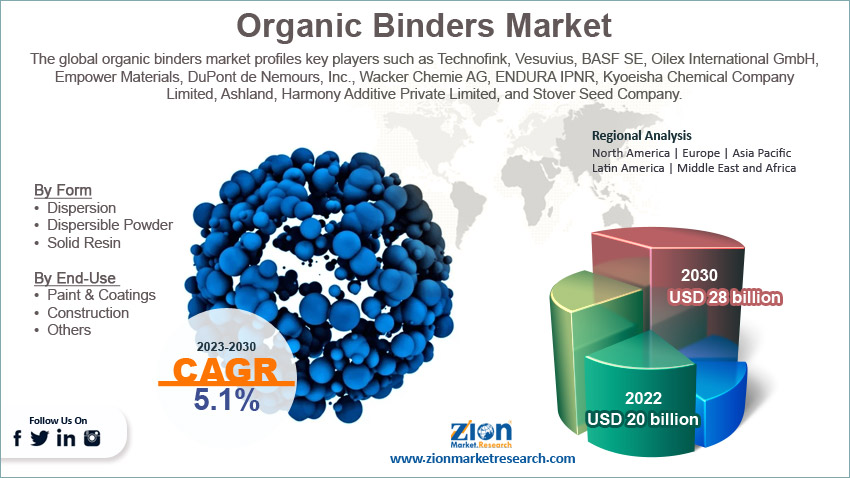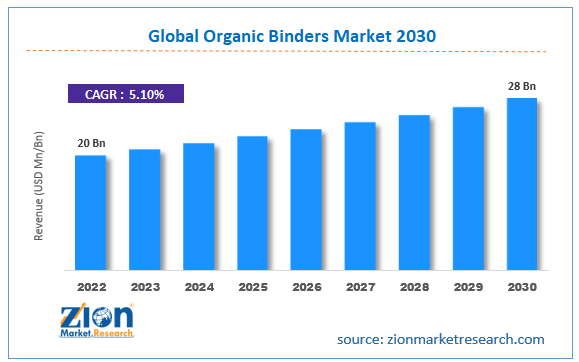Organic Binders Market Size, Share, Growth Report 2032

Organic Binders Market - By Form (Dispersion, Dispersible Powder, and Solid Resin), By End-Use (Paint & Coatings, Construction, and Others), By Product (EVA, Acrylic, Epoxy, Alkyd, and Others), and By Region - Global and Regional Industry Overview, Market Intelligence, Comprehensive Analysis, Historical Data, and Forecasts 2023 - 2030
| Market Size in 2022 | Market Forecast in 2030 | CAGR (in %) | Base Year |
|---|---|---|---|
| USD 20 Billion | USD 21.06 Billion | 5.1% | 2022 |
Organic Binders Industry Prospective:
The global organic binders market size was evaluated at $20 billion in 2022 and is slated to hit $28 billion by the end of 2030 with a CAGR of nearly 5.1% between 2023 and 2030.
Organic Binders Market: Overview
Organic binders are made up of polymers and belong to a family of cellulose. In addition to this, these materials were detected in old Chinese paintings & artworks with the help of various immunological methods like ELISA and immunofluorescence microscopy. They possess exceptional features like mixing ability and minimal change in slip viscosity. Apparently, these materials reduce carbon footprints and hence contribute notably towards the green environment. Moreover, organic binders are extracted from plants, synthetic polymers, and animals. The product finds lucrative applications in the construction industry due to its exceptional physical & chemical properties.
Key Insights
- As per the analysis shared by our research analyst, the global organic binders market is projected to expand annually at the annual growth rate of around 5.1% over the forecast timespan (2023-2030)
- In terms of revenue, the global organic binders market size was evaluated at nearly $20 billion in 2022 and is expected to reach $28 billion by 2030.
- The global organic binders market is anticipated to grow rapidly over forecast timeline owing to low energy consumption, low costs, and eco-friendly features.
- In terms of form, the dispersible powder segment is slated to register the highest CAGR over the analysis period.
- Based on end-use, the paint & coatings segment is projected to record massive surge in the coming years.
- Based on product, the epoxy segment is predicted to lead the market space in the years ahead.
- Region-wise, the European organic binders industry is expected to register the fastest CAGR during the assessment timeline.
 Request Free Sample
Request Free Sample
Organic Binders Market: Growth Factors
Growing product penetration in a slew of end-use sectors to boost global market trends
Breakthroughs in production methods and focus on carrying out research activities on developing new formulas have enlarged the scope of the global organic binders market in the years ahead. Furthermore, low energy consumption, low costs, and eco-friendly features are some of the factors that are slated to steer the global market growth in the coming years. A prominent rise in infrastructural development across the globe is expected to support the growth of the market over the forthcoming years.
Furthermore, a constant search for durable building materials has prompted researchers to produce organic binders having low density along with good rheology. In addition to this, they are trying to enhance the fire properties of concrete structures and hence are making every effort to unravel the potential of organic binders. All these aforementioned factors will drive the global market trends. Rapid demand for organic binders in the construction, automotive, electronics, and electrical sectors will steer the expansion of the market globally. The thriving paints & coatings sector will steer the expansion of the market across the globe. New product launches are predicted to contribute notably towards the global market size in the upcoming years. For instance, Archroma Corporation, a specialty chemicals firm based in Switzerland, launched a new grade of water-based polymeric binders referred to as the Appretan® NTR range which are based on renewable natural ingredients.
Organic Binders Market: Restraints
Low access to required raw materials can inhibit global industry expansion over the forecast period
Different building & construction codes in developed countries such as Germany, the UK, and the U.S. can hinder the expansion of the organic binders industry across the globe. Furthermore, the low availability of necessary raw components in some countries and strict laws related to product use due to growing environmental concerns can impede the growth of the industry globally in the forthcoming years.
Organic Binders Market: Opportunities
Escalating need for enhancing material performance to create new horizons of growth for the global market
The growing use of organic binders in the construction, packaging, automotive, and textiles sectors will open new avenues of growth for the global organic binders market. Furthermore, organic binders help in improving the durability and performance of materials, thereby propping up the expansion of the global market. Furthermore, they provide flexibility, heat resistance, chemical resistance, adhesion, and moisture resistance to materials.
Organic Binders Market: Challenges
Immense product prices can hinder industry expansion across the globe over the forecast timeline
High costs of products and lack of awareness about product benefits can pose a huge challenge to the growth of the global organic binders industry. Easy access to product substitutes along with their cost-effectiveness in comparison to organic binders can pose a big threat to the global industry expansion.
Organic Binders Market: Segmentation
The global organic binders market is sectored into form, end-use, product, and region.
In terms of form, the global organic binders market is segregated into dispersion, dispersible powder, and solid resin segments. Furthermore, the dispersible powder segment, which acquired approximately three-fourths of the global market share in 2022, is forecast to record the fastest rate of growth in the next few years. The growth of the segment during the assessment timeline can be credited to a large-scale use of organic binders in dispersible powder form as it can be easily stored and can resist extreme climatic conditions and seasonal shifts.
Based on the end-use, the global organic binders industry is sectored into paints & coatings, construction, and others segments. Moreover, the construction segment, which gathered the biggest share of the global industry in 2022, is projected to dominate the segmental landscape in the ensuing years. The expansion of the segment within next couple of years can be subject to the humungous demand for organic binders for sustainable construction activities.
Based on the product, the global organic binders market is sectored into EVA, acrylic, epoxy, alkyd, and others segments. Furthermore, the epoxy segment, which garnered nearly 36% of the global market share in 2022, is prognosis to register swift growth in the upcoming years. The growth of the segment during the forecast timeframe can be ascribed to the easy availability of epoxy along with its cost-efficiency. Moreover, epoxy organic binders are utilized for constructing joint materials, robust overlays, floor toppings, and polymer concrete by mixing them with sand aggregates. For the record, the blend of epoxy organic binders and sand aggregates is utilized for building industrial flooring, providing apt solutions to joint nosing repairing services, and providing effective refurbishment & retrofit to damaged structures of concrete of commercial as well as residential buildings. Moreover, these products are heat & moisture-resistant and durable and can withstand extreme climatic conditions.
Organic Binders Market: Report Scope
| Report Attributes | Report Details |
|---|---|
| Report Name | Organic Binders Market |
| Market Size in 2022 | USD 20 Billion |
| Market Forecast in 2030 | USD 28 Billion |
| Growth Rate | CAGR of 5.1% |
| Number of Pages | 214 |
| Key Companies Covered | Technofink, Vesuvius, BASF SE, Oilex International GmbH, Empower Materials, DuPont de Nemours Inc., Wacker Chemie AG, ENDURA IPNR, Kyoeisha Chemical Company Limited, Ashland, Harmony Additive Private Limited, Stover Seed Company, and others. |
| Segments Covered | By Form, By End-Use, By Product, and By Region |
| Regions Covered | North America, Europe, Asia Pacific (APAC), Latin America, Middle East, and Africa (MEA) |
| Base Year | 2022 |
| Historical Year | 2017 to 2021 |
| Forecast Year | 2023 - 2030 |
| Customization Scope | Avail customized purchase options to meet your exact research needs. Request For Customization |
Organic Binders Market: Regional Insights
Asia-Pacific is predicted to maintain a numero uno position in the global organic binders market over the forecast timeline
Asia-Pacific, which amassed nearly 53% of the global organic binders market revenue share in 2022, is predicted to lead the regional market space in the next couple of years. Additionally, the regional market expansion in the upcoming years can be attributed to swift urbanization and industrialization in countries such as China and India in the APAC region. In addition to this, an increase in the construction of houses in the densely populated countries of Asia will further contribute to the growth of the market in the region. Thriving pharmaceuticals, food, leather, and farming sectors will propel the expansion of the market in the sub-continent. The flourishing vehicle manufacturing sector in the region will account significantly for the regional market revenue in the forecasting period.
The European organic binders industry is set to register the highest CAGR in the next eight years subject to an increase in the presence of giant automotive players in the continent along with a rise in the refurbishment activities. In addition to this, the flourishing electronics sector in countries such as the UK, Germany, Finland, Sweden, Norway, Denmark, Estonia, and France will steer the regional industry trends.
Organic Binders Market: Competitive Space
The global organic binders market profiles key players such as:
- Technofink
- Vesuvius
- BASF SE
- Oilex International GmbH
- Empower Materials
- DuPont de Nemours Inc.
- Wacker Chemie AG
- ENDURA IPNR
- Kyoeisha Chemical Company Limited
- Ashland
- Harmony Additive Private Limited
- Stover Seed Company
The global organic binders market is segmented as follows:
By Form
- Dispersion
- Dispersible Powder
- Solid Resin
By End-Use
- Paint & Coatings
- Construction
- Others
By Product
- EVA
- Acrylic
- Epoxy
- Alkyd
- Others
By Region
- North America
- The U.S.
- Canada
- Europe
- France
- The UK
- Spain
- Germany
- Italy
- Rest of Europe
- Asia Pacific
- China
- Japan
- India
- South Korea
- Southeast Asia
- Rest of Asia Pacific
- Latin America
- Brazil
- Mexico
- Rest of Latin America
- Middle East & Africa
- GCC
- South Africa
- Rest of Middle East & Africa
Table Of Content
Methodology
FrequentlyAsked Questions
Organic binders are made up of polymers and belong to a family of cellulose. In addition to this, these materials were detected in old Chinese paintings & artworks with the help of various immunological methods like ELISA and immunofluorescence microscopy.
The global organic binders market growth over forecast period can be owing to Rapid demand for organic binders in the construction, automotive, electronics, and electrical sectors.
According to a study, the global organic binders industry size was $20 billion in 2022 and is projected to reach $28 billion by the end of 2030.
The global organic binders market is anticipated to record a CAGR of nearly 5.1% from 2023 to 2030.
The European organic binders industry is set to register the fastest CAGR over the forecasting timeline subject to an increase in the presence of giant automotive players in the continent along with a rise in the refurbishment activities. In addition to this, the flourishing electronics sector in countries such as the UK, Germany, Finland, Sweden, Norway, Denmark, Estonia, and France will steer the regional industry trends.
The global organic binders market is led by players such as Technofink, Vesuvius, BASF SE, Oilex International GmbH, Empower Materials, DuPont de Nemours, Inc., Wacker Chemie AG, ENDURA IPNR, Kyoeisha Chemical Company Limited, Ashland, Harmony Additive Private Limited, and Stover Seed Company.
The organic binders market report covers the geographical market along with a comprehensive competitive landscape analysis. It also includes cash flow analysis, profit ratio analysis, market basket analysis, market attractiveness analysis, sentiment analysis, PESTEL analysis, trend analysis, SWOT analysis, trade area analysis, demand & supply analysis, Porter’s five force analysis, and value chain analysis.
RelatedNews
HappyClients
Zion Market Research
Tel: +1 (302) 444-0166
USA/Canada Toll Free No.+1 (855) 465-4651
3rd Floor,
Mrunal Paradise, Opp Maharaja Hotel,
Pimple Gurav, Pune 411061,
Maharashtra, India
Phone No +91 7768 006 007, +91 7768 006 008
US OFFICE NO +1 (302) 444-0166
US/CAN TOLL FREE +1 (855) 465-4651
Email: sales@zionmarketresearch.com
We have secured system to process your transaction.
Our support available to help you 24 hours a day, five days a week.
Monday - Friday: 9AM - 6PM
Saturday - Sunday: Closed






